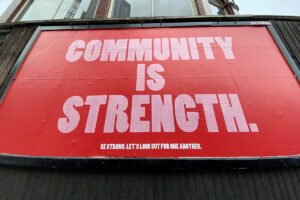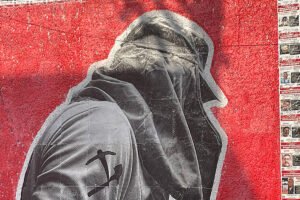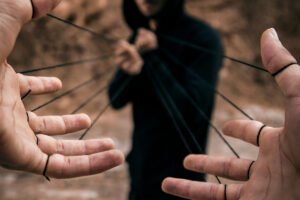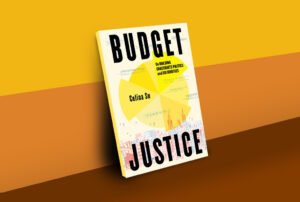
Editors’ note: This piece is from Nonprofit Quarterly Magazine’s spring 2024 issue, “‘Stop Drowning Us, and Stop Making Us Disappear’: A Critical Report on the State of Black Woman Leadership.”
I lost myself a long time ago. I say this in a spirit of vulnerability and honesty. I have become merely a vessel for whom and how I serve. I am a Black woman, mother, wife, caregiver to a parent with violent dementia, nonprofit leader, writer, poet, an imaginative spirit, a wildflower, and a creative soul. As such, a traditional narrative would not do justice to the pain, joy, beauty, hope, love, fear, despair, and exhaustion that come with my everyday.
In this moment in time, I am broken and often sad.
I am on a journey figuring out what it means to be me.
When I rediscover myself, it will be important to answer the questions, Who am I uninterrupted? How has nonprofit leadership unraveled me?
This anthology is an homage to my fragmented spirit.
I thank NPQ for creating the space for Black Women to tell a portion of our story.
Chapter 1
There are so many things that we do to shape our whole lives around these internal messages of “you’re not good enough” and “you are unworthy.” Carrying the burden of silence, racial trauma, and shame is exhausting and soul-crushing.
—Deran Young, in You Are Your Best Thing1
My nonprofit executive leadership journey has been fraught with legitimizing my worth and value since the beginning. I ascended to the top position of my organization in an emergent transition of leadership during a financial crisis in 2017. In reaction to learning the unimaginable, and due to a lack of resources for any other option, the board asked me to step into the role of CEO of an insolvent organization.
When the organization was strong, I wasn’t enough—despite my overqualifications. My Black leadership only became relevant—and an option of last resort—when the organization became insolvent and in crisis.
This once strong and mission-driven nonprofit was on the brink of dissolution. Given the contributions I had made during my nine-year tenure—including serving as interim CEO—I was deserving of much more than being thrust into crisis management without compensation (I went months unpaid until I was able to raise the money for my position). Under the weight of urgency and the pressure of legitimizing my worth, I rebuilt the organization from the inside out.
This is the backdrop to my burnout and my resilience.
Imagine discovering that a 20-year-old organization has only $5,000 in the bank, with no immediate prospects of earned or contributed revenue. Also imagine your board both being largely unaware of this insolvency and feeling ill-equipped to resolve the issue. This was the beginning of my tenure as chief program officer turned CEO during an emergency board meeting. Couple this with the fact that I had been overlooked for the position of CEO a couple of years prior, in 2014, while serving as interim CEO. Despite having the most tenure and experience to lead, I was made to feel like a token placeholder while the board searched for the permanent hire.
When the organization was strong, I wasn’t enough—despite my overqualifications. My Black leadership only became relevant—and an option of last resort—when the organization became insolvent and in crisis.
Prior to the emergency transition, and in what appeared to be a gesture of good faith, my predecessor had offered me the opportunity to become CEO. She had announced her desired transition to the board, and my promotion had become part of her succession plan. The transition timeline and the weeks leading up to her departure felt fraught with urgency and uncertainty, which led me to audit the financial position of the organization. Upon discovery of the cash position and my disclosure to the board, my predecessor was immediately asked to step down, and I was offered the official role.
There are several reasons why the organization suffered a financial crisis, some of which were outside of my predecessor’s control. However, what was in her control was the courage to be forthright about the gravity of the situation and the challenges I would be inheriting. Instead, she handed me a three-pronged binder with a Wonder Woman logo on the cover, filled with various protocols and Excel documents. It was insulting and laughable. I became the Black superhero charged with fixing an organization I had not broken. When the board was on the precipice of closing the doors, I became mission control and the sole person who believed deeply in the need for the organization to continue. Unsurprisingly, my predecessor landed safely on her feet in another leadership position. The optics shielded her and the board from any culpability.
In the tumultuous days after my appointment there was a wave of White flight. Lacking any accountability and moving quickly to dissociate themselves, the executive committee stepped down quietly via email, followed by a trail of board resignations. On the morning of what was meant to be another emergency board meeting, I was left without a fully functioning board. Uncertain of the road ahead and angered at how the situation had played out, the three Black women on the board remained. Having less than a year of tenure, they stepped into the role of my executive committee and crisis management team, absent any procedural formalities.
Surrounded by palpable doubt of my capabilities, pending payroll, no foreseeable revenue, no operational reserves, and a fractured governance infrastructure, I took the helm. Several colleagues and friends (all Black women) suggested I turn down the position, saying that my years of experience—and my humanity—deserved more respect.
Despite their urging, I felt responsible for the livelihood of the remaining employees, the 20 years of incredible mission work at the organization, and the grassroots and community-based organizations we served. I was trapped between the internal and external pressures of being high performing and seizing what felt like my only chance to lead. Holding this tension of being a dynamic, strategic thinker, visionary, and mobilizer with the unrelenting stress of leading an organization through crisis was horrific. I could not emote any feeling, let alone my fury that my leadership would be defined by this pivotal moment. I was embarrassed that I had felt the need to say yes to the position, but comforted that I had the protection of Black women. I willingly went months without pay to ensure that my team would be compensated, and I worked diligently to eliminate the $400,000-plus debt, all fueled by a deep-seated need to prove my worth—a decision I would never make again, under any circumstance.
Crisis management, organization turnaround, and cultural revitalization became my niche. Burnout and fatigue became my twisted badge of honor. I relied on Black women for my survival. I give thanks to the incredible sisterhood and partnership of Black women who stepped in to support me during that time, including but not limited to: Donna Murray-Brown; Sarida Scott; Yodit Mesfin Johnson; Allandra Bulger; Michelle Crockett; Khalilah Spencer; Lysa Davis; Tosha Tabron; and Tahirih Ziegler.
Black women support Black women.
Holding this tension of being a dynamic, strategic thinker, visionary, and mobilizer with the unrelenting stress of leading an organization through crisis was horrific. I could not emote any feeling, let alone my fury that my leadership would be defined by this pivotal moment.
One of those Black women leveraged her professional network to convene a meeting with all our funders, resulting in two of those black women leveraging their positional privilege in philanthropy to garner two emergency grants totaling $125,000. This catalytic investment provided the roadmap for trusted financial support from other foundations, eliminating our debt and ensuring our cash position for years to come.
Three of those Black women became my executive committee.
Five of those Black women provided a circle of trusted confidantes.
All of them were hell-bent on watching me thrive and not allowing the circumstances that I inherited to define my leadership story. With their unwavering support and collective power, Michigan Community Resources emerged stronger and positioned as a leader in the nonprofit sector.
It is important to note that I was placed in a position to undoubtedly fail. My accountant noted that it would be a miracle to eradicate the six-figure deficit and repair the reputational harm it had created. Yet in three months, this was accomplished.
Three months. All while I was pregnant.
I rarely revel in the magnitude of that accomplishment.
There is something about writing it down and reading my own words that is a reminder of my magic.
I would be remiss if I didn’t give special thanks to Alisha Butler and Ji Lee, who played an instrumental role in saving the organization. As women, thought-partners, strategic leaders, and allies at MCR, Alisha and Ji transformed our work and mission for the better.
Women support women.
Chapter 2
I do nothing alone. My whole life is a collaboration.
—Tricia Hersey, The Nap Ministry’s Rest Deck2
The Transforming Solidarity Collective was born in sisterhood and a collective sense that we are better together. The names that follow may look familiar—because Black and Brown women support Black and Brown women.
The executive directors, presidents, and CEOs of Michigan Nonprofit Association; Community Development Advocates for Detroit; Michigan Community Resources; Co.act Detroit; and Nonprofit Enterprise at Work came together in 2020 at the urgent rallying cry of Yodit Mesfin Johnson, president and CEO of Nonprofit Enterprise at Work. This table-setting allowed for a much-needed space for the Black and Brown leadership of those organizations to come together and lament, pray, organize, plan, and hold sacred space for our humanity in the middle of a pandemic.
We found moments of rest and reprieve in that space. We shared resources and strategies for our leadership and organizational strength amid so many pandemic unknowns. The fruits of our togetherness created a framework, supported by philanthropic investment, to ensure that Southeast Michigan’s nonprofits—especially those from historically underresourced communities—had access to resources and services to advance their mission.
Allandra Bulger, Madhavi Reddy, Donna Murray-Brown, and Yodit Mesfin Johnson are magical and divine. The container created by this collective was a reminder of why Black and Brown women in nonprofit leadership fellowships are so important, that Black and Brown women matter, and that our voices and experiences are critical to the sector.
The table-setting allowed for the support and development of the Rest and Liberation Initiative—an initiative, as I write in the report’s prologue, that is “rooted in Black joy and possibility”:
Sign up for our free newsletters
Subscribe to NPQ's newsletters to have our top stories delivered directly to your inbox.
By signing up, you agree to our privacy policy and terms of use, and to receive messages from NPQ and our partners.
It is a liberation walk that will become a model for the sector.…It is a community-building exercise that holds space for a coalition of the willing to transform work–life balance, compensation and benefits, and workplace culture in nonprofits. It is a mirror, forcing us to see the ways in which we are complicit in perpetuating cycles of exhaustion and fatigue in our sector.3
Chapter 3
My body is sacred. Exhaustion does not honor the sacred.
—Tricia Hersey, The Nap Ministry’s Rest Deck4
Message from my OB/GYN on 11/22/2017: “Give me a call at your earliest convenience, Shamyle. We have the results from your recent ultrasound, and I would like to discuss some things with you. Thanks. Dr. Davis.”
There were two.
I delivered one live birth. I delivered one stillbirth. I delivered an organization.
It was always meant to be two. But the body under pressure can destroy more than just our physical health.
During the financial crisis of MCR and my ascent into emergent leadership, I was pregnant with twin girls. Only one survived.
Her name is Soleil Carolyn Maria Dobbs. She is something special.
Her sister, Celeste Maria Dobbs, is spiritually with us in the MIGHTY spirit of my ONE. Soleil is light and love. Yet she is also fire and feistiness. She grew in my belly during one of the most stressful times of my career. I quietly grieved the loss of her sister and buried it deep in the recesses of my mind. Without missing a beat, I continued to work.
I delivered one live birth. I delivered one stillbirth. I delivered an organization.
Chapter 4
I am enough now.
—Tricia Hersey, The Nap Ministry’s Rest Deck5
Behind the curtains of nonprofit leadership are our whole and full lives.
I am my father’s keeper.
I am his guardian, conservator, caregiver, private chef, financial steward, and only family here in Michigan. I manage everything from his medical appointments down to the daily fight to bathe, eat, and take his medication. He doesn’t remember me on most days, and is verbally and physically abusive. He has been put out of most medical facilities due to his violent outbursts, and I have gone through eight caregivers in 2023 alone.
My leadership lines were blurred with familial responsibilities.
I spent most of 2023 directly caring for my father, as it has been largely impossible to maintain home-care assistance. Through the graces of God and the universe conspiring to save me, I met an amazing woman who is a retired nurse with a home-care business. Tenita and her team are answers to a prayer.
Black women support Black women.
I was dying—spiritually and physically. Imagine needing rest in 2020, and moving your father in with you for 24/7 care at the brink of your exhaustion. My entire body, spirit, and soul were under siege. My marriage suffered, my children suffered, my ability to lead effectively suffered, my health suffered—and anyone who saw me saw my brokenness.
But there was a light at the end of the tunnel.
While developing the framework for the Rest and Liberation Initiative, MCR developed a sabbatical policy for staff with five-plus years tenure. I was able to leverage this newly minted policy to take 10 weeks off to care for my father.
Chapter 5
I will do less. Watch me thrive.
—Tricia Hersey, The Nap Ministry’s Rest Deck6
At the top of January 2024, I learned that I had been selected for the Eugene Miller Fellowship, offered by the McGregor Fund. Launched in 2009 and honoring trustee emeritus Eugene Miller for his years of distinguished leadership, the program rewards outstanding, experienced leaders of McGregor-funded nonprofit organizations in Metro Detroit.
This fellowship, combined with the Rest and Liberation Initiative sabbatical, will be my long play in refining how I resist grind culture. I will find and reprioritize myself. These two opportunities, taken together, offer freedom.
Informed by my experience, the RLI is but one answer to the question of how we change the narrative for Black and Brown nonprofit leaders. This newly conceptualized sabbatical and fellowship program will provide opportunities for time away from work for leaders of small-budget nonprofit organizations predominantly staffed by and/or led by people of color. MCR worked alongside Community Development Advocates of Detroit, Co.act Detroit, and Nonprofit Enterprise at Work over the last three years to talk with our sector and understand how nonprofit leaders are feeling. The overwhelming response was that folks feel burnt out, with no end in sight.
Traditional sabbatical programs are inaccessible to leaders of small-budget organizations for a variety of reasons. We created a program that responds to the specific needs of these leaders, including up-front investment in organizational capacity to plan and prepare for the leader’s temporary leave, and a direct investment in the individual leader to use in whatever way brings them to a more restful state—including childcare, elder care, travel expenses, and the like.
The RLI also creates opportunities for nonprofit leaders and staff to access rest and time away from work outside of a sabbatical. Some leaders are unable to take three months away from work, or have not yet reached a point in their career when a sabbatical makes sense. Work–life balance and accessible time off should be the norm for leaders across the sector. Providing physical space for rest, advocating for organizational policies that allow for adequate paid time off, and leading conversations on mental health and work–life balance are examples of how the RLI aims to contribute.
The RLI also seeks to build community among sabbatical participants and leaders across the sector, in recognition that sharing experiences builds solidarity and community, and helps rally progress toward sector-wide change.
The RLI is, for me, a deeply personal response to the ways in which leaders of color aren’t supported to balance work and personal life. It is a call to action for the nonprofit sector and philanthropy to think about how to rebalance these things—not just by creating a sabbatical program but also by reconsidering how we approach work culture itself, so that it can be more sustainable.
We are hopeful that the initiative and effort will garner national attention and additional support. We are actively fundraising for it.
* * *
After I studied Black women and was immersed in our history and our stories, I saw me. Like, I just saw me. I didn’t see me through the lens of whiteness and the stories that are told about me and people who look like me. I saw me. I saw what I am capable of. I saw that my story started at a deficit because I was reading a narrative written by someone who created a version of me that was twisted and wrong.
—Aiko D. Bethea, in You Are Your Best Thing7
I so appreciate this platform. These stories are important. Our experiences matter and illuminate the need for more curated spaces for Black joy and liberation—and dedicated resources to support just that.
Support Black women supporting women.
Notes
- Deran Young, “Honoring Our Stories, Transforming Our Pain,” in You Are Your Best Thing: Vulnerability, Shame Resilience, and the Black Experience, ed. Tarana Burke and Brené Brown (New York: Random House, 2021), 125.
- Tricia Hersey, The Nap Ministry’s Rest Deck: 50 Practices to Resist Grind Culture (San Francisco, CA: Chronicle Books, 2023).
- The Rest and Liberation Initiative: 2023 Report & Recommendations (Detroit, MI: Michigan Community Resources, in partnership with Community Development Advocates of Detroit, Co.act Detroit, and Nonprofit Enterprise at Work, 2023), 5.
- Hersey, The Nap Ministry’s Rest Deck.
- Ibid.
- Ibid.
- Aiko D. Bethea, “Steps to Being Whole, on Your Terms,” in You Are Your Best Thing, 190.








